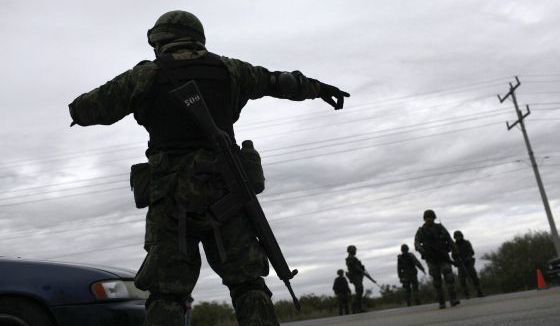Criminal organizations in Tamaulipas state are growing their ranks through forced recruitment
Jan Martínez Ahrens
Mexico City
The cattle-raising towns of Estación-Manuel and Aldama lie
37.5 kilometers apart. The trip by car takes an average 27 minutes. It
is a short if somewhat torturous ride, but the new bus lines, which
feature internet and bathroom facilities, make it comfortable enough –
that’s unless you doze off and get woken up by a group of hooded men
offering a ticket to hell.
According to federal police officers, this
has happened three times on the route in the last few weeks. The most
alarming aspect is not that it is happening in turbulent Tamaulipas,
where the drug lords hold a sword over the military’s head, or that
they fleece passengers of every single thing they own. What’s most
frightening is the final goal: the forcible recruitment of people to
grow the drug gangs’ ranks. This chilling practice has extended across
the state, which is on the border with Texas.
“These are not robberies,” says Luis Norberto Montoya,
coordinator of the state’s federal police force. “We are dealing with
criminal groups that want to kidnap people.”
The victims are usually illegal Central American immigrants
who are trying to get to the United States. The Zetas (deserters from
elite Mexican forces) and the once-almighty Gulf Cartel are the groups
responsible. The organizations and their satellite groups are also
fighting a ruthless territorial battle. In this war, the control of the
highways – the main channel for drugs and immigrants – is of cardinal
importance.
Hundreds of hitmen patrol the roads. They move around
comfortably in these parts, except for sporadic and violent skirmishes
with security forces. Sometimes they dress like police officers and set
up fake checkpoints. Sometimes they kidnap people by daylight, calmly,
without fuss. Such was the fate of a busload of passengers traveling
down the Ciudad Victoria-Matamoros route.
According to passenger testimonies, the driver decided to
stop the car around 5pm because of a damaged rim. As he slowed down, a
pickup truck stopped and, with a smile, its driver offered the bus
conductor a hand. The conductor said no.
The friendly young man returned 10 minutes later with two
other pickups filled with armed men who wore more serious faces. In that
moment, the lives of some of the 20 travelers took an unexpected turn.
Two hitmen got on the bus and made six young people get
off. They then told the others to keep quiet. The captives were forced
to kneel on the asphalt and had their faces covered with their own
shirts. Then, the men hauled them into the trucks en route to their new
destination. A witness said no one said anything, not even when the cars
were out of sight. The bus conductor quietly fixed the rim and then the
passengers continued their trip. “We were terrorized and dumbstruck,”
the passenger recalls.
Oddly, the police see this bloodcurdling recruitment method
as a positive development, a sign of the cartels’ waning power. “It
shows that we are gaining ground,” Montoya says. According to this line
of thinking, the cartels – exhausted after years of combat with the army
and weakened by their own internal wars – are now resorting to all
kinds of tactics to replenish their ranks.
“That is absurd,” says Eduardo Guerrero, a security
specialist and former advisor to the President’s Office. “If the
police’s strategy were working, the criminals would be arrested and they
would not be assaulting buses in broad daylight. That they can do so
shows that the organization is expanding and looking for new recruits.”
Since 2011, when former President Felipe Calderón’s
war on organized crime reached its peak, the kidnapping and forced
recruitment of bus passengers was thought to be a thing of the past.
Officials have not revealed the number of abducted
individuals in the last few weeks but sources close to the police say
there were about 20. The captives were taken to training camps and later
became hitmen or bodyguards. Few of those kidnapped refuse to comply.
They know what the price would be. “It’s a brutal world,” Guerrero says.
“There was a case in 2010 where they took the young people out, gave
them bats so they could fight each other, and then chose the strongest
ones.”
The reappearance of this practice is closely linked to the
deterioration of Tamaulipas – a state that is home to three percent of
the Mexican population but where 30 percent of all the country’s
kidnappings takes place. Located on the border with Texas, Tamaulipas is
a natural route for trade with the United States and thus one of the
bloodiest battlefields in drug trafficking, especially between the Gulf
Cartel and the Zetas. This all-out war has led to the total erosion of
the region’s legal authorities.
In May, President Enrique Peña Nieto ordered military
troops to take over security in the state. He dismantled 40 police
forces suspected of collaborating with criminals. Since then, the
government has been fighting an underground battle against the cartels.
Officials hardly ever tell the public about the initiative and it has
not succeeded in eradicating the violence.
As a bus conductor who covers the Mexico City-Tamaulipas route says,
“everyone has to watch his own back here. The truth is that I am not
going to play the hero. In the end they have the winning hand.”

No comments:
Post a Comment